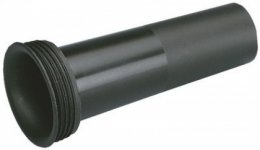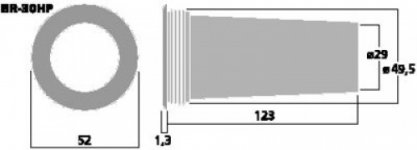So I've used these several times and having just used them again an element of doubt is creeping in as the ports are actually slightly tapered over the length.
My question is when modelling in WinISD is the inside diameter they specify the one I should be using given its taper?
If the images aren't clear the specifications for this particular port are:
Inside Ø29mm
Outside Ø49.5mm
Length 123mm
Flange Ø52mm
Area (SV)6.6cm2
My question is when modelling in WinISD is the inside diameter they specify the one I should be using given its taper?
If the images aren't clear the specifications for this particular port are:
Inside Ø29mm
Outside Ø49.5mm
Length 123mm
Flange Ø52mm
Area (SV)6.6cm2
Attachments
Is it not a bit odd that the tube has this tapering? Would it not be better if the tube had a shape with a waist in the middle instead?
I tried to get my head around this....as I have some.
As soon as you cut them to a shorter length the 'measured' internal diameter is larger.
The only sensible way I could think it througj was this.....simulate your port..this will give a diameter and a length from which you can work out a volume. Assuming your tapered port is nominally around the diameter of the sim, now pour given volume of water into the port....having sealed the end obviously....Mark where the water lies and cut here.?!
As soon as you cut them to a shorter length the 'measured' internal diameter is larger.
The only sensible way I could think it througj was this.....simulate your port..this will give a diameter and a length from which you can work out a volume. Assuming your tapered port is nominally around the diameter of the sim, now pour given volume of water into the port....having sealed the end obviously....Mark where the water lies and cut here.?!
I use those tubes, they are efficient in reducing vent noise, require a perfect hole, but if inserted half way can be removed easily (good for tests).
They are a bit difficult to model as the length is uncertain due to the shape, so to achieve the tuning I need I have to measure impedance and find the minimum in the graph. I usually cut them in steps.
Ralf
They are a bit difficult to model as the length is uncertain due to the shape, so to achieve the tuning I need I have to measure impedance and find the minimum in the graph. I usually cut them in steps.
Ralf
I tend to make an average of the two end SDs and use that then measure and adjust. I find them a pita to mount and cut holes for.
You can simulate the exact port shape in hornresp.
You can simulate the exact port shape in hornresp.
- Home
- Loudspeakers
- Multi-Way
- Bass reflex ports - Monacor

